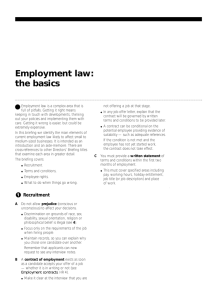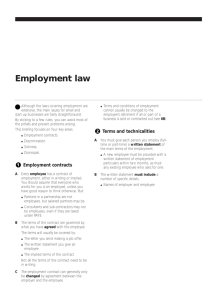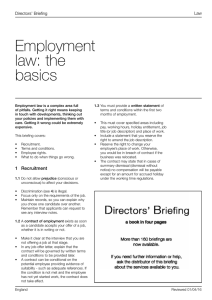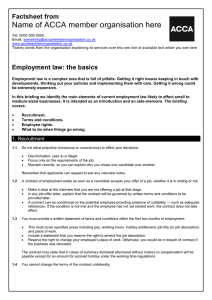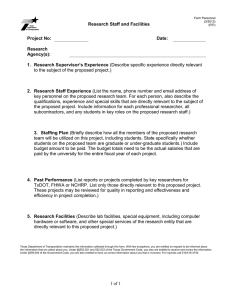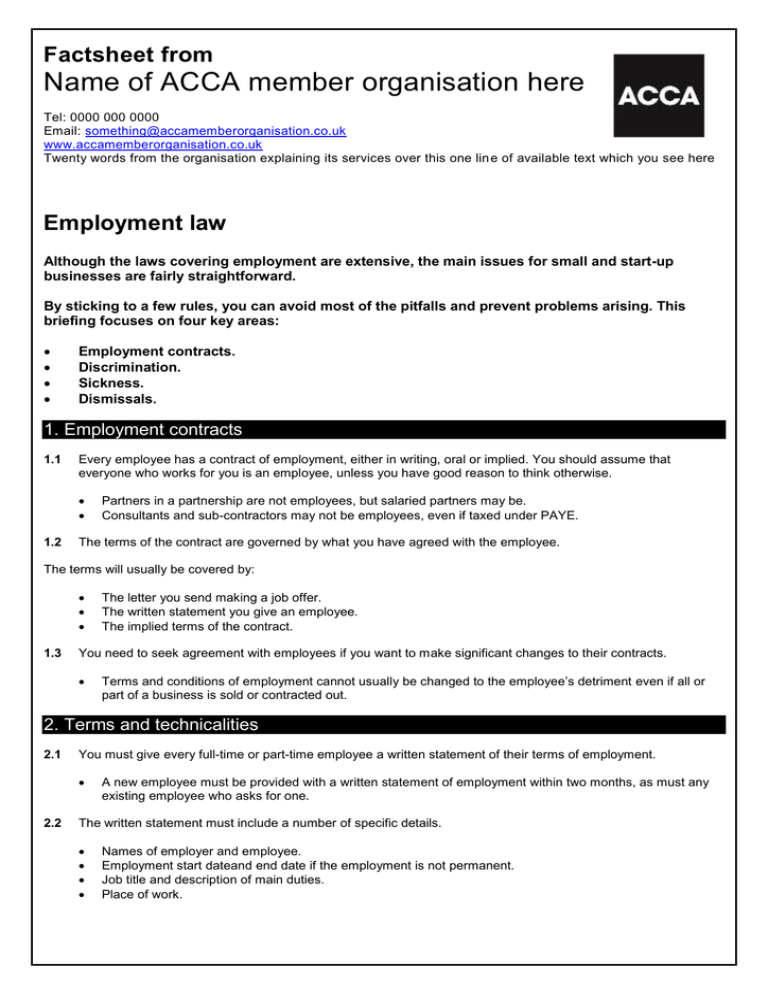
Factsheet from
Name of ACCA member organisation here
Tel: 0000 000 0000
Email: something@accamemberorganisation.co.uk
www.accamemberorganisation.co.uk
Twenty words from the organisation explaining its services over this one lin e of available text which you see here
Employment law
Although the laws covering employment are extensive, the main issues for small and start-up
businesses are fairly straightforward.
By sticking to a few rules, you can avoid most of the pitfalls and prevent problems arising. This
briefing focuses on four key areas:
Employment contracts.
Discrimination.
Sickness.
Dismissals.
1. Employment contracts
1.1
Every employee has a contract of employment, either in writing, oral or implied. You should assume that
everyone who works for you is an employee, unless you have good reason to think otherwise.
1.2
Partners in a partnership are not employees, but salaried partners may be.
Consultants and sub-contractors may not be employees, even if taxed under PAYE.
The terms of the contract are governed by what you have agreed with the employee.
The terms will usually be covered by:
1.3
The letter you send making a job offer.
The written statement you give an employee.
The implied terms of the contract.
You need to seek agreement with employees if you want to make significant changes to their contracts.
Terms and conditions of employment cannot usually be changed to the employee’s detriment even if all or
part of a business is sold or contracted out.
2. Terms and technicalities
2.1
You must give every full-time or part-time employee a written statement of their terms of employment.
2.2
A new employee must be provided with a written statement of employment within two months, as must any
existing employee who asks for one.
The written statement must include a number of specific details.
Names of employer and employee.
Employment start dateand end date if the employment is not permanent.
Job title and description of main duties.
Place of work.
2.3
The written statement can refer to other documents (eg a disciplinary manual).
2.4
These other documents must be made available for the employee to read.
Some common sense terms are implied.
2.5
Pay rate and how often paid.
Hours of work and holiday entitlement.
Notice periods.
Sick pay and pension arrangements.
Grievance and disciplinary procedures.
Details of any collective agreements.
The employer must ensure employees’ health and safety at work, have a safety policy and carry out risk
assessments. You must treat employees with respect. Harassment, bad language or humiliating treatment
may lead to claims for constructive dismissal and discrimination.
Employees must obey reasonable instructions, use skill and care in their work, and act faithfully and
honestly.
Put all the important terms in writing. Without a written agreement, you will lose three advantages:
Flexibility (eg the ability to move an employee to a different job).
Certainty (eg if anything is unclear, this could lead to disputes).
Protection when an employee leaves (eg terms preventing former employees from revealing confidential
information).
3. Discrimination
3.1
It is illegal to treat someone less favourably on the basis of their race, sex or gender reassignment, age,
disability, sexual orientation, religion, philosophical belief, membership or non-membership of a trade union,
marital or civil partnership status, pregnancy, maternity, care responsibilities or part-time status.
3.2
Requirements or conditions of employment should not discriminate against any group.
3.3
Do not advertise or ask interview questions in a manner that discriminates.
Men and women are entitled to equal pay for similar work, or work of the same value.
Promotion and training opportunities must also be non-discriminatory.
3.4
Positive discrimination (eg in favour of women) is also likely to be illegal, because it is discriminating against
someone else. Training may be an exception.
3.5
You can be responsible for discrimination practised by employees, including sexual harassment or racial abuse.
3.6
Employment tribunals can award unlimited compensation to victims of discrimination.
4. Sickness
Workers are entitled to statutory sick pay (SSP), usually after four or more days’ sickness.
4.1
SSP is the minimum level of payment you must make to any qualifying worker.
SSP is payable for up to 28 weeks for any one period of sickness.
The current payment is £86.70 per week subject to income tax and employee’s NI.
Many employers pay higher sick pay.
2
If your company’s arrangements are more generous than the statutory minimum, you can offset your payments
against the SSP you would have had to pay.
4.2
Most workers who are not fit to work will qualify for SSP.
4.3
You may be able to reclaim the extra from HMRC if the SSP exceeds 13% of your gross NI contributions in
any month. Check to see if you can recover what you have paid using the SSP calculator on the HMRC
website www.hmrc.gov.uk.
They must earn more than the NI lower earnings limit (£109 2013/14).
Part-timers, full-timers and agency workers qualify, as length of service is irrelevant.
The ‘fit note’ is issued by doctors and indicates whether an individual is:
Not fit for work.
May be fit for work.
A ‘may be fit for work’ statement would be given if the doctor believes your worker’s health condition may allow
them to work, if you give them appropriate support.
4.4
You can withhold SSP if you reasonably suspect the worker is not ill.
4.5
A worker who has recently drawn a statutory benefit (eg incapacity or maternity benefit) may not qualify.
If you want to stop paying SSP to someone who has been away more than four times in a year, seek an
adjudication from HMRC Medical Services.
You need the worker’s written consent. A refusal may justify stopping SSP.
5. Dismissals
5.1
If the contract does not specify a notice period, an employee is entitled to a ‘reasonable period of notice’.
Employees’ are entitled to at least the statutory minimum of one week after one month’s employment increasing
at the rate of one extra week per year up to a maximum of 12 weeks’ notice.
5.2
If you dismiss an employee without the right notice, this will be wrongful dismissal.
5.3
If an employer breaches the contract, and the breach was material going to the root of the contract, the employee
may be able to resign immediately and claim constructive dismissal.
5.4
The employee is usually entitled to normal remuneration (both salary and benefits) during the notice period.
This applies even if you wish to end the employment immediately, unless there was gross misconduct or the
employee suffers no financial loss (eg by immediately starting a new job at a better rate of pay) or if you have
reserved the contractual right to pay salary in lieu of notice without benefits.
For example, if you reduce pay without agreement, or tell the employee to resign.
An employee with two years’ continuous service who started work after 5 April 2012 (one year if employment
commenced prior to this date) who is dismissed without a fair reason and reasonable treatment can claim unfair
dismissal.
You are required to act ‘fairly and reasonably’ when dismissing an employee (or carrying out any other
disciplinary procedure). See the Acas Code of Practice on Disciplinary and Grievance Procedures at
www.acas.org.uk/index.aspx?articleid=2174.
If a dismissal is unfair, an employee can ask the tribunal to order re-employment or award compensation.
The basic award is £13,500 (depending on age and length of service) and compensation for financial loss up
to a maximum of £74,200.
3
If you unreasonably failed to follow the Acas Code, the compensation awarded against you can be
increased by 25%. Equally an employee that unreasonably failed to follow the code could have any
compensation reduced by 25%.
Where possible, seek professional advice before dismissing an employee.
5.5
If an employee decides to leave your business, you can usually require him or her to work out the full notice
period.
5.6
If the employee refuses to work out the notice period, he or she will not be entitled to be paid for it.
If you insist the employee must stop work immediately, or before the notice period ends, you must still pay
what would have been earned during the notice period.
If you both agree that the employment should end straight away, no further payment needs to be made.
Employees with less than two years’ service are not entitled to redundancy pay.
Tax is not payable in respect of statutory redundancy pay.
Payments to an employee in lieu of notice are tax-free in some circumstances (under £30,000). Check with
your accountant.
Avoid claims that a redundancy is unfair dismissal by ensuring that it is genuine. In general, the job must
have disappeared.
The employer must select employees on a fair and objective basis, after reasonable consultation, with
adequate notice and a fair appeals procedure.
You are no longer entitled to ‘retire employees’ and you can only make them redundant after a fair
procedure.
6. Other rights
6.1
Employees have the right to the national minimum wage (NMW) which stands at £6.31 for employees aged 21
and over.
6.2
There is a lower rate of £5.03 for those aged 18 to 20, £3.72 for those aged 16 and 17 and £2.68 for
apprentices under the age of 19, or older but in the first year of their apprenticeship.
Casual staff, agency staff and home workers also have a right to this wage.
Service charges, tips, gratuities and cover charges paid to a worker t hrough payroll do not count
towards NMW.
Each employee must get a pay statement.
This must show total gross pay, deductions and net pay.
Deductions must be itemised. Apart from income tax and National Insurance (NI), deductions can only be
made with the employee’s agreement or to correct previous overpayments.
6.3
When a business is transferred to a new owner, all employee rights usually remain.
6.4
Trade unions and their members have extra rights (eg time off for union duties).
Hours and leave
A.
With certain exceptions, employees have the right to a maximum 48-hour working week, normally averaged over
a 17-week period.
Workers who agree to work more than 48 hours a week must sign a written agreement to do so.
Employers must keep records and must not press workers to sign opt-out forms.
B.
All workers are entitled to 5.6 weeks’ annual leave pro rata.
C.
New parents are entitled to take time off for the birth and care of their children.
4
D.
Parents or carers of a child under 17 or a disabled child under 18, or a parent or carer of a dependent adult, has
a statutory right to make a request for flexible working. This right will be extended to all employees in 2014.
E.
Birth or adoption entitles each parent or carer to 18 weeks’ unpaid leave during the early years of a child’s
life.
Mothers have a right to ordinary and additional maternity leave, regardless of length of service.
Fathers (or those with responsibility for bringing up children) who have worked continuously for at least 26
weeks by the end of the 15th week before the baby is due can take up to two weeks’ paid paternity leave and
– providing the mother has returned to work - up to 26 weeks’ additional paternity leave .
One member of an adopting couple take up to 39 weeks’ paid ordinary adoption leave and 13 weeks’ unpaid
additional adoption leave, if they have worked for you continuously for at least 26 weeks by the time the child
is matched. If the other parent has worked for you for at least 26 weeks by the time the child is matched, he
or she can take 26 weeks’ additional adoption leave providing the first has returned to work.
You must ‘consider seriously’ any request and may only refuse an application if there is a clear business
reason.
All employees are entitled to dependant care leave.
Workers can take ‘reasonable’, unpaid time off to deal with an emergency involving a dependant.
Handle with care
A pregnant woman has a number of rights:
A.
Paid time off for ante-natal care.
B.
26 weeks’ statutory ordinary maternity leave and 26 weeks' additional maternity leave (AML), during which all her
contractual rights (except remuneration) continue.
C.
Statutory maternity pay (SMP), if she has completed 26 weeks’ service by the end of the 15th week before the
expected week of childbirth.
D.
It is illegal to let a woman return to work within two weeks of childbirth, or within four weeks if the work is in a
factory.
You must pay SMP for 39 weeks. SMP is not payable for the last 13 weeks of AML.
Some SMP may be deductible from your employer’s NI contributions. Phone the HMRC employers’ helpline
for details (0300 200 3200).
Women who are ineligible for SMP can claim maternity allowance from Jobcentre Plus based on their recent
employment and earnings record.
The right to claim unfair dismissal, if she is dismissed for any reason to do with the pregnancy or childbirth.
If she is dismissed, you must give written reasons, without having to be asked.
Note
Ask Acas, your solicitor or your local business support organisation for advice when drawing up a written contract.
Acas offers free advice on employment issues (08457 47 47 47 or www.acas.org.uk).
Note
There is no default retirement age (DRA) and workers can retire when they want to. Employment contracts cannot be
terminated unless there is a fair reason for dismissal such as for capability or conduct, or the employer can ‘objectively
5
justify’ a forced retirement age, which for most employers is unlikely. Download the Acas guide, Working without the
Default Retirement Age from www.acas.org.uk.
Note
Employees adopting ‘employee-owner’ or ‘employee-shareholder’ status give up some of their employment rights in
return for shares in the business. Employee-owners: are not eligible for statutory redundancy pay; are not entitled to
ordinary unfair dismissal protection; must give 16 weeks’ notice (instead of the normal eight) if they want to return early
from maternity or adoption leave; do not have the statutory right to request flexible working or time off for training; are
not protected against dismissal for making a request for flexible working (except in relation to requests to work flexibly
on return from parental leave).
Expert contributors
Thanks to Amanda Galashan (EmployEase, 020 7831 5052).
Further Help
Last updated 01.10.13
© Atom Content Marketing 2013. ISSN 1469-0470. All rights reserved. No part of this publication may be reproduced or transmitted without the
written permission of the publisher. This publication is for general guidance only. The publisher, expert contributors and distributor disclaim all liability
for any errors or omissions. Consult your local business support organisation or your professional adviser for help and advice.
6

